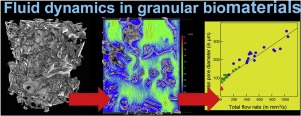Micron ( IF 2.5 ) Pub Date : 2020-02-29 , DOI: 10.1016/j.micron.2020.102861 Daniel Chappard , Jean-Daniel Kün-Darbois , Bernard Guillaume

|
Granules of calcium/phosphate biomaterials are used to fill small bone defects in oral and maxilla-facial surgery. Granules of natural (e.g., trabecular bone, coral) or synthetic biomaterials are provided by industry. Small granules can also form of putty. The 3D geometry of granules creates a macroporosity allowing invasion of vascular and bone cells when pores are larger than 300 μm. We analyzed the 3D-porosity of 11 different stacks of biomaterials: Osteopure®, CopiOs®, Bio-Oss®, TCP Dental HP®, KeraOs®, TCH®, Biocoral®, EthOss® and Nanostim®. For each granular biomaterial, two sizes of granules were analyzed: small and large. Microcomputed tomography (microCT) determined porosity and microarchitectural characteristics of the biomaterials stacks. Computational fluid dynamics (CFD), a simulation method, was used on the stacks of microCT images.
Stacks of small granules had a much lower permeation and fluid velocity than large granules and the hydraulic tortuosity was increased. Significant correlations were observed between microarchitecture parameters (porosity, mean pore diameter and specific surface) and fluid dynamic parameters. The two putties were associated with low (or absence of) porosity and permeation study revealed a very low (or absence) of flow rate. Stacks of granules represent 3D scaffolds resembling trabecular bone with an interconnected porous microarchitecture. Small granules create pores less than 300 μm in diameter; this induces a low fluid flow rate. CFD simulates the accessibility of body fluids and progenitor cells and confirms that it is depending on the shape and 3D arrangements of granules within a stack. Large granules must be preferred to putties and small granules.
中文翻译:

来自可用于骨移植的商业生物材料microCT堆栈的计算流体动力学模拟
钙/磷酸盐生物材料颗粒用于填充口腔和上颌面手术中的小骨缺损。工业界提供天然(例如小梁骨,珊瑚)或合成生物材料的颗粒。小颗粒也可以形成腻子的形式。颗粒的3D几何形状会产生大孔,当孔大于300μm时允许血管和骨细胞浸润。我们分析了11种不同生物材料堆栈的3D孔隙度:Osteopure®,Copios®,Bio-Oss®,TCP DentalHP®,KeraOs®,TCH®,Biocoral®,EthOss®和Nanostim®。对于每种颗粒生物材料,分析了两种大小的颗粒:小颗粒和大颗粒。微型计算机断层扫描(microCT)确定了生物材料堆栈的孔隙率和微结构特征。计算流体动力学(CFD)是一种模拟方法,用于microCT图像堆栈。
与大颗粒相比,小颗粒堆的渗透性和流体速度要低得多,并且水力曲折度增加了。在微体系结构参数(孔隙度,平均孔径和比表面积)与流体动力学参数之间观察到显着相关性。这两个油灰的孔隙率低(或不存在),渗透研究表明流速非常低(或不存在)。一堆颗粒代表了3D支架,类似于小梁骨,具有相互连接的多孔微体系结构。小颗粒会产生直径小于300μm的孔;这导致低的流体流速。CFD模拟体液和祖细胞的可及性,并确认它取决于堆叠中颗粒的形状和3D排列。











































 京公网安备 11010802027423号
京公网安备 11010802027423号